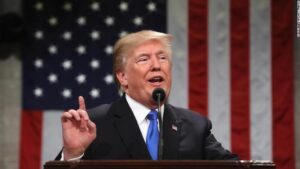by The Cowl Editor on February 8, 2018
News
by Darren Squillace ’19

President Trump gave his first State of the Union address on Tuesday, January 30. Reading off of a teleprompter, Trump’s speech was concise in comparison to his usual off-the-cuff speeches that viewers have grown accustomed to. Instead of trying to divide those on both ends of the political spectrum, Trump tried to rally Americans together with unifying statements such as, “So let us begin tonight by recognizing that the state of our Union is strong because our people are strong.”
In regards to the content of the speech itself, it has received a mixed bag of reviews. According to a poll conducted by CNN, Trump’s speech received the least positive reactions in recent history, with 48 percent of viewers giving his speech a “very positive” review.
Throughout his speech, Trump included both heartwarming and inspirational stories that showed America and its people in the best light possible. Some of these stories included that of Preston Sharp, a 12-year-old boy who started an initiative when he realized there were no American flags over the graves of veterans on Memorial Day and raised over 40,000 flags as a salute to veterans.
When discussing the external threats Americans face from rogue regimes, Trump told the story of Ji Seong-ho, a North Korean defector who escaped the dictatorship on wooden crutches after injuring his legs in a train accident that led to the amputation of his left leg without the use of anesthesia.
These stories, regardless of partisanship or ideological agenda, received applause from both sides of the aisle. However, when Trump got to the meat of his speech, discussing issues facing the United States, the audience in the Chambers of Congress became completely divided.
Some of the main issues Trump focused his speech on were the economy, infrastructure, and immigration. Trump touted several recent economic successes since he has taken office, including approximately 2.4 million jobs that have been created since his election victory, the investment in and building of distribution plants in the U.S. by corporations such as Apple and Fiat-Chrysler, and the lowest African-American and Hispanic-American unemployment rates in history.
He attributed many of these successes to the GOP tax bill that was recently passed, which has lowered the corporate tax rate to 20 percent and lowered the taxes of many individuals yet has been unfavorably perceived by the majority of Americans according to most polls.
The one issue that Trump really tried extending an olive branch of unity towards Democrats in was immigration. To the dissent of his supporters, Trump proposed a four-pillar plan for immigration in exchange for the permanent citizenship of 1.8 million “dreamers” who are here in the U.S. under the provisions of DACA.
Trump’s proposed barter on immigration and his speech in general was universally criticized by Democrats, as many saw his reference to MS-13 gangs as well as other crimes committed by illegal immigrants as a cruel overgeneralization of a vast majority of people who genuinely wish to become contributing Americans. Trump’s speech reinforced his stance on many controversial issues, including unemployment and immigration. With Republicans holding the Senate at 51-49, the effect the State of the Union address will have on the upcoming mid-term elections remains unknown.